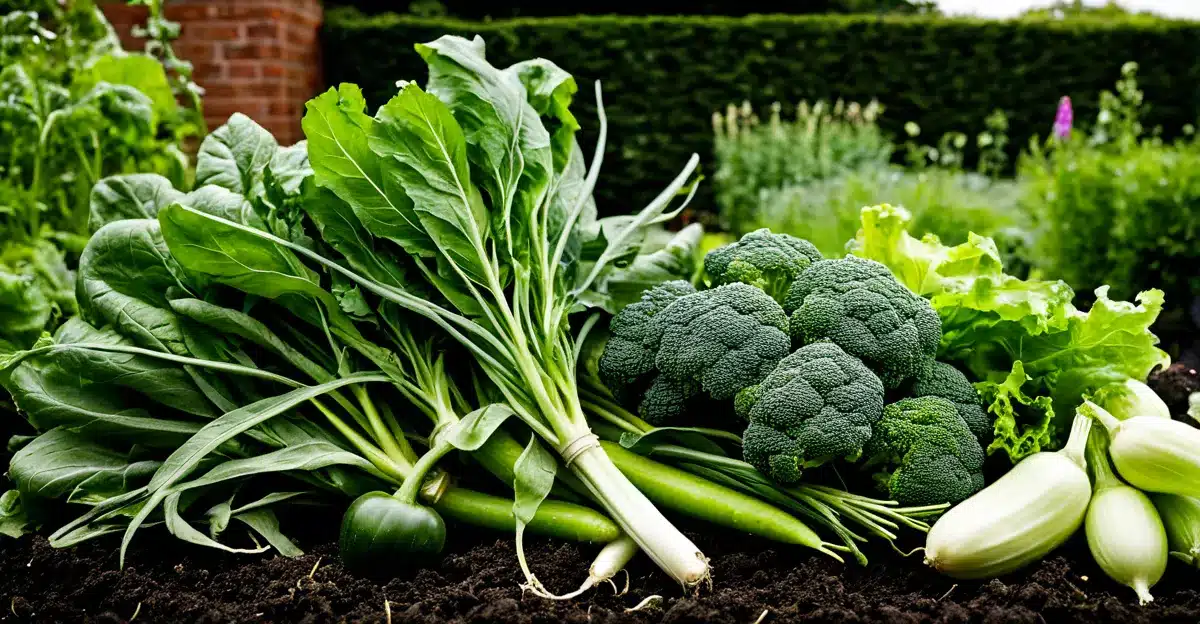Essential Steps for Growing Vegetables in a UK Garden
Understanding the UK climate gardening conditions is crucial for a successful vegetable garden. The UK’s weather is often cool and damp, with a relatively short growing season. Choosing vegetable varieties that thrive in these conditions will increase your chances of a bountiful harvest. For example, hardy vegetables like cabbage, kale, and carrots are well-suited to the UK’s climate, while more tender plants may require protection.
A clear step-by-step guide helps streamline the gardening process. Start by selecting an appropriate location with good sunlight and well-draining soil. Prepare the soil by adding organic matter such as compost to improve fertility and structure. Next, choose vegetables based on your local frost dates and planting calendar. Sow seeds or transplant seedlings accordingly, ensuring adequate spacing to promote healthy growth.
Have you seen this : What are the top tips for winter-proofing your UK garden?
Consistent watering, particularly in dry spells, and regular weeding are essential to maintain plant health. Mulching can help retain soil moisture and suppress weeds, saving both time and effort. As harvest time approaches, monitoring vegetable maturity ensures picking at peak freshness.
To maximize success, follow these vegetable gardening tips:
Additional reading : How can I create a garden retreat in my UK backyard?
- Avoid planting too early to prevent frost damage.
- Rotate crops yearly to reduce soil-borne diseases.
- Use row covers or cloches for added protection during cold snaps.
By understanding the specifics of UK vegetable gardening and following this step-by-step guide, gardeners can effectively navigate the challenges posed by the climate, apply proven techniques, and ultimately enjoy a productive vegetable harvest.
Selecting Suitable Vegetables for the UK Climate
Understanding climate-appropriate vegetables ensures a thriving UK garden.
Choosing the best vegetables UK gardeners can grow involves considering local weather patterns and soil conditions. The UK’s temperate climate—with its mild summers and wet winters—favors hardy, resilient crops that can tolerate variable conditions. Vegetables such as kale, cabbage, carrots, and leeks are widely recommended because they thrive in cooler temperatures and can withstand occasional frosts.
When deciding between heirloom vs hybrid varieties, it is important to recognize that hybrids often offer increased disease resistance and faster maturity, which are advantageous given the UK’s unpredictable weather. However, heirloom varieties may be preferred by gardeners who prioritize flavor and diversity. For instance, heirloom tomatoes can provide superior taste, but may require extra care in colder UK gardens.
To maximize success, gardeners can follow a seasonal vegetable chart for UK gardens, planting cold-tolerant crops like broad beans and peas in early spring, and warm-weather crops such as courgettes and beans in late spring after frost risk. This approach aligns vegetable growing cycles with the UK climate, ensuring a bountiful harvest.
Preparing the Soil for Successful Vegetable Growth
Essential steps for fertile and productive UK vegetable gardens
Understanding the soil preparation UK requires is the foundation of any thriving vegetable garden. In the UK, common garden soils range from heavy clay to sandy textures, each demanding different care. First, assess your UK vegetable garden soil by checking its texture, drainage, and nutrient levels. Adequate drainage is critical in the often damp UK climate, so consider incorporating organic matter to improve structure and prevent waterlogging.
One of the most effective ways to enhance soil fertility is through composting UK gardens. Adding well-rotted compost enriches the soil with essential nutrients and beneficial microorganisms, significantly boosting vegetable growth. This practice not only improves soil texture but also encourages water retention in sandy soils and aeration in denser clays.
When preparing your growing area—whether raised beds, containers, or traditional plots—start by clearing debris and weeds. For raised beds and containers, mix high-quality compost with local soil to create an ideal growing medium. In traditional plots, digging in compost and natural amendments such as garden manure or leaf mold can transform poor soils, making them more conducive to vegetable health. Regularly turning and aerating the soil during this phase ensures roots will penetrate easily and access nutrients efficiently.
Planning and Timing Your Planting Schedule
Mastering your planting calendar UK is vital to a productive garden.
Understanding when to plant vegetables UK relies heavily on recognizing the country’s distinct growing seasons and local frost dates. The UK climate features a cold winter, a cool spring, a warm summer, and mild autumn. Frost can occur as late as April and early in October, so timing is crucial. Using a planting calendar UK helps gardeners avoid the risk of frost damage and take full advantage of the growing season by starting seeds indoors or sowing directly outdoors at optimal times.
A monthly planting calendar for popular UK vegetables organizes tasks so you know exactly when to plant peas, carrots, beans, or lettuces. For example, March through May is ideal to sow early crops like radish and spinach outside, while tomatoes and peppers often need an indoor start in March. Later in the summer, sowing autumn crops like kale and turnips keeps your garden productive well into fall.
Succession planting is a smart strategy to maximize yields — by planting a new crop immediately after harvesting the earlier one, you enjoy a continuous harvest. Combined with crop rotation, which involves changing where each vegetable family is planted each season to prevent soil depletion and reduce disease, you set yourself up for a year-round harvest.
By integrating a detailed planting calendar UK with succession planting and crop rotation, gardeners can efficiently navigate the seasonal gardening UK demands. This approach leads to healthier plants and an abundant supply of fresh produce throughout the year.
Effective Pest and Disease Management in UK Gardens
Managing pests and diseases effectively in UK gardens demands an understanding of local challenges and sustainable solutions. UK garden pest control starts with identifying common culprits such as aphids, slugs, and caterpillars, which frequently affect vegetables and ornamental plants alike. Recognising signs early—like chewed leaves or sticky residues—can help gardeners act promptly and avoid widespread damage.
For vegetable disease prevention UK, it is essential to monitor crops for fungal infections like blight and powdery mildew, which thrive in the humid British climate. Early detection paired with good sanitation—removing diseased plant material and rotating crops—plays a crucial role in keeping these diseases in check.
Implementing organic pest solutions UK promotes a healthy ecosystem within the garden, favouring beneficial insects like ladybirds that naturally control pests. Using neem oil, insecticidal soaps, or homemade remedies can reduce chemical use while effectively deterring unwanted insects. Companion planting also supports pest management by attracting helpful insects or repelling harmful ones.
By combining vigilant observation, sound cultural practices, and natural remedies, gardeners in the UK can maintain healthy plants and minimise the impact of pests and diseases without relying heavily on synthetic chemicals. This integrated approach ensures long-term garden vitality and sustainability.
Regular Care and Maintenance for Thriving UK Vegetable Gardens
Proper vegetable garden maintenance UK is key to ensuring healthy, productive plants through every season. A well-planned watering schedule UK gardening adapts to the region’s variable rainfall and temperatures. For example, while natural rainfall can suffice during wetter months, supplementary watering becomes essential in drier spells, focusing on early morning or late evening to minimize evaporation and root stress. Consistent moisture promotes nutrient uptake and prevents issues like wilting or blossom drop.
Feeding vegetables UK gardens correctly means using balanced fertilizers rich in nitrogen, phosphorus, and potassium, depending on the plant’s growth stage. Applying feed every two to three weeks encourages vigorous growth while avoiding over-fertilization, which can lead to leaf burn or reduced fruiting. Organic options such as compost or well-rotted manure also improve soil structure alongside nutrition.
Maintaining your vegetable garden involves more than watering and feeding. Pruning, thinning, and staking are vital. Pruning removes dead or crowded leaves, enhancing airflow and reducing disease risk. Thinning seedlings ensures individual plants have enough space to flourish, which directly influences root development and yield. For crops like tomatoes or beans, staking supports growth and prevents damage from wind or heavy fruit load.
If you notice poor growth or unusual symptoms such as yellowing leaves or stunted plants, troubleshoot promptly. Factors may include inconsistent watering, nutrient deficiencies, pests, or soil issues. Monitoring your plants regularly allows for early detection and targeted interventions, which keeps your garden thriving in the demanding UK climate.
Useful Tools, Resources, and Visual Guides for UK Gardeners
Unlocking practical support for your UK vegetable gardening journey
Successful UK gardeners consistently rely on trusted tools and resources tailored to the unique climate and soil conditions found across the region. Whether you’re a beginner or an experienced green thumb, having access to the right UK gardening tools can dramatically improve planting success and overall garden health.
For starters, hand tools like trowels, pruning shears, and soil testers are indispensable. These allow precise soil preparation and ongoing maintenance essential for crops to thrive in the British climate. Digital weather apps and soil moisture sensors are also increasingly popular among UK vegetable gardeners, helping them schedule watering and protect plants from unexpected frosts.
Visual aids are particularly helpful when it comes to timing and plant selection. UK planting guides often feature detailed calendars indicating the optimal sowing windows for vegetables such as peas, carrots, and brassicas. These guides typically present month-by-month schedules combined with diagrams illustrating spacing and depth for seeds, offering an intuitive way for gardeners to plan both indoor seed starting and outdoor planting.
Reliable expertise is key, so gardeners frequently turn to online forums and dedicated vegetable gardener resources specific to the UK climate. Organizations such as Royal Horticultural Society provide comprehensive advice that accounts for local regional variations, from soil types to typical weather patterns. These platforms allow gardeners to troubleshoot problems, share success stories, and stay updated on best practices and seasonal reminders.
By combining hands-on tools, visual planting calendars, and community-backed advice, UK gardeners are well-equipped to grow flourishing, productive vegetable gardens throughout the year.


